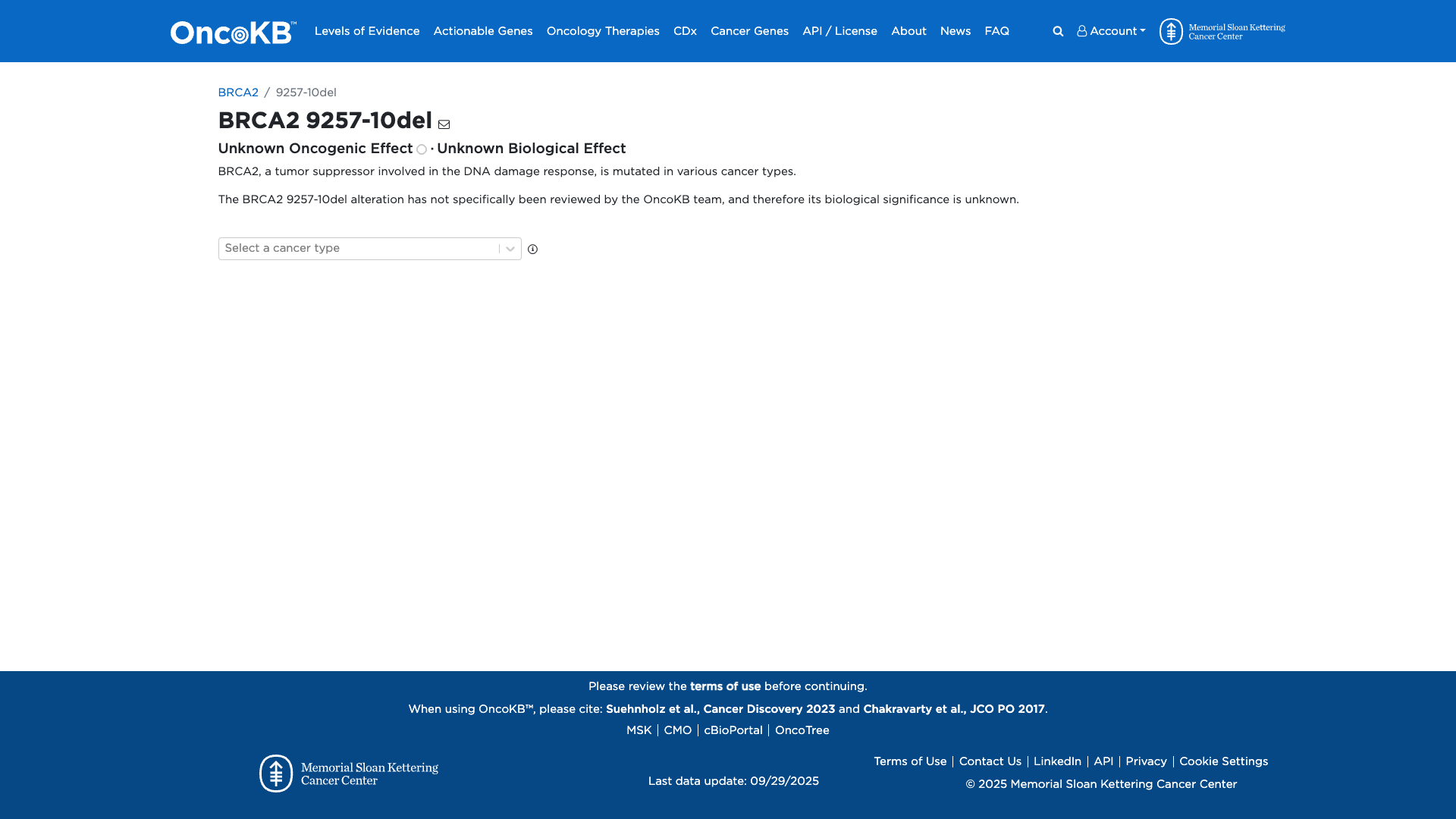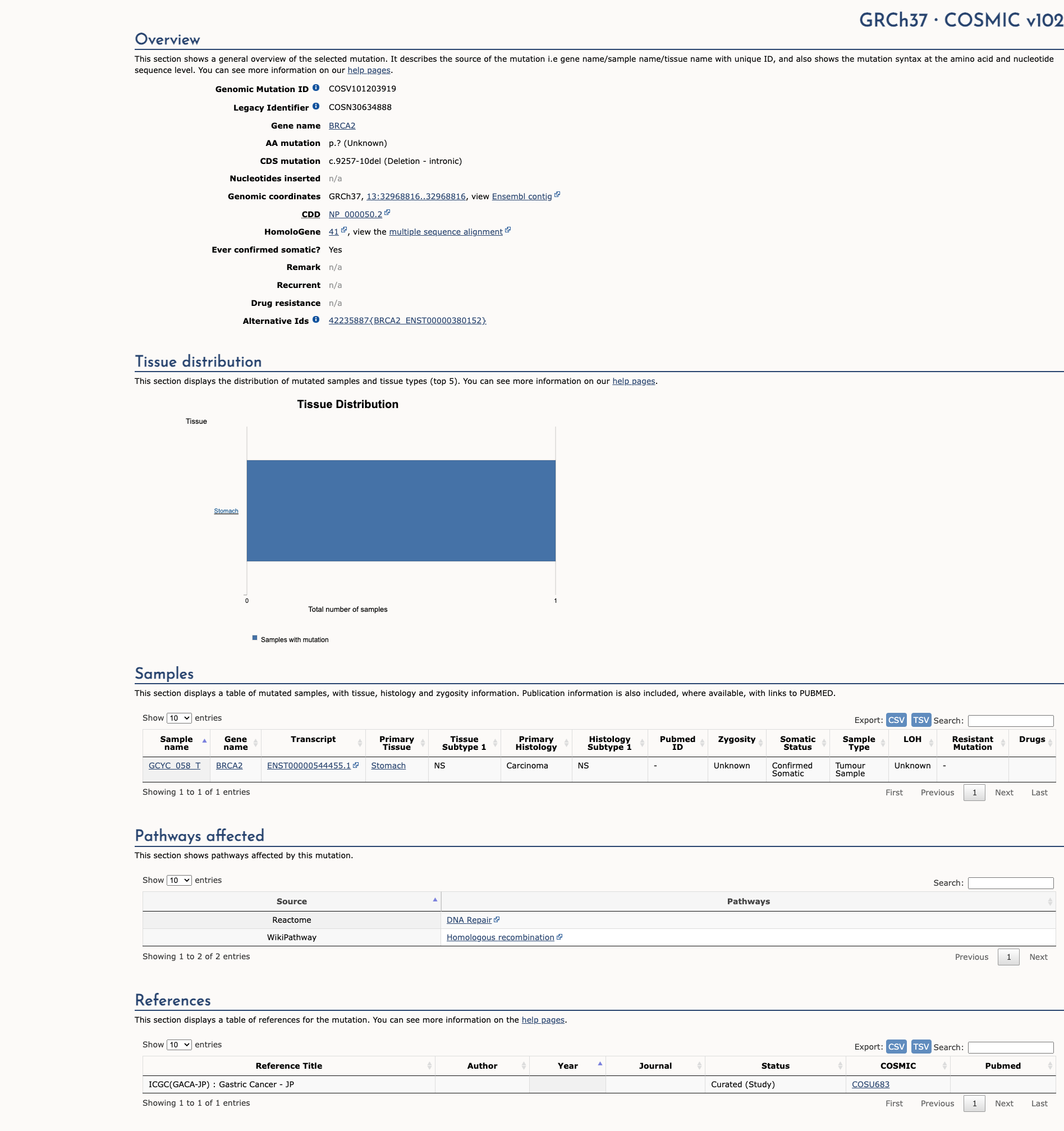BRCA2 c.9257-10del, p.?
NM_000059.4:c.9257-10del
COSMIC ID: COSN30634888
Variant of Uncertain Significance (VUS)
This intronic BRCA2 variant (c.9257-10delT) is rare in population databases (PM2_Supporting), shows no computational evidence of splicing impact (BP4_Supporting), and has a low allele frequency consistent with BS1_Supporting. No evidence fulfills pathogenic or stronger benign criteria, resulting in classification as a Variant of Uncertain Significance.
ACMG/AMP Criteria Applied
PM2
BS1
BP4
Genetic Information
Gene & Transcript Details
Gene
BRCA2
Transcript
NM_000059.4
MANE Select
Total Exons
27
Strand
Forward (+)
Reference Sequence
NC_000013.10
Alternative Transcripts
| ID | Status | Details |
|---|---|---|
| NM_000059.2 | Alternative | 27 exons | Forward |
| NM_000059.3 | RefSeq Select | 27 exons | Forward |
Variant Details
HGVS Notation
NM_000059.4:c.9257-10del
Protein Change
?
Location
Exon 24
(Exon 24 of 27)
5'Exon Structure (27 total)3'
Functional Consequence
Loss of Function
Related Variants
Alternate Identifiers
COSN30634888
Variant interpretation based on transcript NM_000059.4
Genome Browser
Loading genome browser...
HGVS InputNM_000059:c.9257-10del
Active Tracks
ConservationRefSeqClinVargnomAD
Navigation tips: Use mouse to drag and zoom. Click on features for details.
Clinical Data
Global Frequency
0.00221%
Rare
Highest in Population
European (Finnish)
0.00411%
Rare
Global: 0.00221%
European (Finnish): 0.00411%
0%
0.05%
0.1%
1%
5%
10%+
Allele Information
Total: 271950Alt: 6Homozygotes: 0
ACMG Criteria Applied
PM2
This variant is present in gnomAD (MAF= 0.00221%, 6/271950 alleles, homozygotes = 0) and at a higher frequency in the European (Finnish) population (MAF= 0.00411%, 1/24324 alleles, homozygotes = 0). The variant is rare (MAF < 0.1%), supporting PM2 criterion application.
Classification
Uncertain Significance (VUS)
Based on 6 submitter reviews in ClinVar
Submitter Breakdown
1 VUS
4 LB
1 B
Pathogenic
Likely Path.
VUS
Likely Benign
Benign
Publications (0)
No publication details.
Clinical Statement
This variant has been reported in ClinVar as Likely benign (4 clinical laboratories) and as Uncertain significance (1 clinical laboratories) and as Benign (1 clinical laboratories).
Functional Impact
Functional Domain
Hotspot Status
Not a hotspot
Domain Summary
This variant is not located in a mutational hotspot or critical domain (0 mutations).
Related Variants in This Domain
Functional Summary
The BRCA2 9257-10del variant has not been functionally characterized, and its biological significance remains unknown.
Database Previews
OncoKB

JAX-CKB

Click on previews to view full database entries. External databases may require institutional access.
Computational Analysis
Pathogenicity Predictions
Predictor Consensus
Unknown
PP3 Applied
No
VCEP Guidelines
Applied ACMG/AMP Criteria (VCEP Specific) VCEP Guidelines
PVS1
PVS1 (Not Applied) Strength Modified
According to VCEP guidelines, the rule for PVS1 is: "Very Strong Null variant (nonsense, frameshift, splice site (donor/acceptor +/−1,2), initiation codon, single or multi-exon deletion) in a gene where LOF is a known mechanism of disease." The evidence for this variant shows it is an intronic deletion at position c.9257-10, outside the canonical +/−1,2 splice sites. Therefore, this criterion is not applied because the variant does not affect a canonical splice site.
PS1
PS1 (Not Applied) Strength Modified
According to standard ACMG guidelines, the rule for PS1 is: "Same amino acid change as a previously established pathogenic variant regardless of nucleotide change." The evidence for this variant shows it is intronic with no predicted protein change. Therefore, this criterion is not applied because there is no amino acid alteration.
PS2
PS2 (Not Applied) Strength Modified
According to standard ACMG guidelines, the rule for PS2 is: "De novo (both maternity and paternity confirmed) in a patient with the disease and no family history." No data on de novo occurrence are available for this variant. Therefore, this criterion is not applied.
PS3
PS3 (Not Applied) Strength Modified
According to VCEP guidelines, the rule for PS3 is: "Well-established in vitro or in vivo functional studies supportive of a damaging effect." No functional studies exist for this variant. Therefore, this criterion is not applied.
PS4
PS4 (Not Applied) Strength Modified
According to VCEP guidelines, the rule for PS4 is: "The prevalence of the variant in affected individuals is significantly increased compared to the prevalence in controls (p≤0.05, OR≥4)." There are no case-control data for this variant. Therefore, this criterion is not applied.
PM1
PM1 (Not Applied) Strength Modified
According to VCEP guidelines, the rule for PM1 is: "Located in a mutational hot spot or well‐studied functional domain without benign variation." This variant is intronic outside of any known functional domain. Therefore, this criterion is not applied.
PM2
PM2 (Supporting) Strength Modified
According to VCEP guidelines, the rule for PM2 is: "Supporting: Absent from controls in gnomAD v2.1 and v3.1 (non‐cancer subsets)." The evidence for this variant shows a gnomAD non-cancer allele count of 6/271,950 (MAF=0.00221%), which meets the absence/rarity requirement. Therefore, this criterion is applied at Supporting strength because the variant is extremely rare in controls.
PM3
PM3 (Not Applied) Strength Modified
According to VCEP guidelines, the rule for PM3 is: "Applied for BRCA2 Fanconi Anemia phenotype with trans variants." No Fanconi Anemia or trans-variant evidence is available. Therefore, this criterion is not applied.
PM4
PM4 (Not Applied) Strength Modified
According to VCEP guidelines, the rule for PM4 is: "Protein length changes due to in-frame indels or stop-loss." This variant is intronic with no coding sequence change. Therefore, this criterion is not applied.
PM5
PM5 (Not Applied) Strength Modified
According to standard ACMG guidelines, the rule for PM5 is: "Novel missense change at an amino acid residue where a different missense change is pathogenic." This variant is intronic with no amino acid change. Therefore, this criterion is not applied.
PM6
PM6 (Not Applied) Strength Modified
According to standard ACMG guidelines, the rule for PM6 is: "Assumed de novo without confirmation of paternity and maternity." No data support unconfirmed de novo status. Therefore, this criterion is not applied.
PP1
PP1 (Not Applied) Strength Modified
According to VCEP guidelines, the rule for PP1 is: "Co-segregation with disease in multiple affected family members." No segregation data are available. Therefore, this criterion is not applied.
PP2
PP2 (Not Applied) Strength Modified
According to standard ACMG guidelines, the rule for PP2 is: "Missense variant in a gene with low rate of benign missense variation." This variant is intronic. Therefore, this criterion is not applied.
PP3
PP3 (Not Applied) Strength Modified
According to VCEP guidelines, the rule for PP3 is: "Supporting for predicted splicing impact (SpliceAI≥0.2) or missense impact in functional domain." SpliceAI predicts a score of 0.01 (≤0.1), indicating no splicing impact. Therefore, this criterion is not applied.
PP4
PP4 (Not Applied) Strength Modified
According to VCEP guidelines, the rule for PP4 is: "Phenotype specificity (LR≥2.08)." No specific clinical phenotype data are available. Therefore, this criterion is not applied.
PP5
PP5 (Not Applied) Strength Modified
According to standard ACMG guidelines, the rule for PP5 is: "Reputable source reports variant as pathogenic without available evidence." This practice is no longer recommended. Therefore, this criterion is not applied.
BA1
BA1 (Not Applied) Strength Modified
According to VCEP guidelines, the rule for BA1 is: "Stand Alone if FAF>0.001 (0.1%)." The variant MAF of 0.00221% (0.0000221 fraction) is below 0.1%. Therefore, this criterion is not applied.
BS1
BS1 (Supporting) Strength Modified
According to VCEP guidelines, the rule for BS1 Supporting is: "FAF>0.00002 (0.002%) and ≤0.0001 (0.01%)." The variant fractional frequency is 6/271,950 = 0.0000221 (0.00221%), which falls within this range. Therefore, this criterion is applied at Supporting strength because the allele frequency is greater than expected for a pathogenic variant but below levels for stronger benign codes.
BS2
BS2 (Not Applied) Strength Modified
According to VCEP guidelines, the rule for BS2 is: "Observed in healthy individuals without recessive phenotype." No such data are available. Therefore, this criterion is not applied.
BS3
BS3 (Not Applied) Strength Modified
According to VCEP guidelines, the rule for BS3 is: "Well-established functional studies show no damaging effect." No functional assays exist for this variant. Therefore, this criterion is not applied.
BS4
BS4 (Not Applied) Strength Modified
According to VCEP guidelines, the rule for BS4 is: "Lack of segregation in affected family members." No segregation data are available. Therefore, this criterion is not applied.
BP1
BP1 (Not Applied) Strength Modified
According to VCEP guidelines, the rule for BP1 is: "Silent or missense variant outside functional domain, no splicing predicted." This variant is intronic. Therefore, this criterion is not applied.
BP2
BP2 (Not Applied) Strength Modified
According to standard ACMG guidelines, the rule for BP2 is: "Observed in trans with a pathogenic variant for a dominant disorder." No data on co-occurrence are available. Therefore, this criterion is not applied.
BP3
BP3 (Not Applied) Strength Modified
According to standard ACMG guidelines, the rule for BP3 is: "In-frame indels in repetitive regions without known function." This is an intronic deletion. Therefore, this criterion is not applied.
BP4
BP4 (Supporting)
According to VCEP guidelines, the rule for BP4 is: "Supporting for intronic variants outside the native splice sites (±1,2) with SpliceAI≤0.1." This variant is −10 intronic with SpliceAI score 0.01. Therefore, this criterion is applied at Supporting strength because computational evidence predicts no impact on splicing.
BP5
BP5 (Not Applied) Strength Modified
According to VCEP guidelines, the rule for BP5 is: "Cases with pathogenic variants in two different breast–ovarian cancer genes have no specific phenotype." No co-observation data are available. Therefore, this criterion is not applied.
BP6
BP6 (Not Applied) Strength Modified
According to standard ACMG guidelines, the rule for BP6 is: "Reputable source reports variant as benign without evidence." This approach is no longer recommended. Therefore, this criterion is not applied.
BP7
BP7 (Not Applied) Strength Modified
According to VCEP guidelines, the rule for BP7 is: "Supporting for intronic variants at or beyond positions +7/−21 with BP4 met." This variant is at position −10, which is within the conserved motif region (−21 to −1). Therefore, this criterion is not applied.

